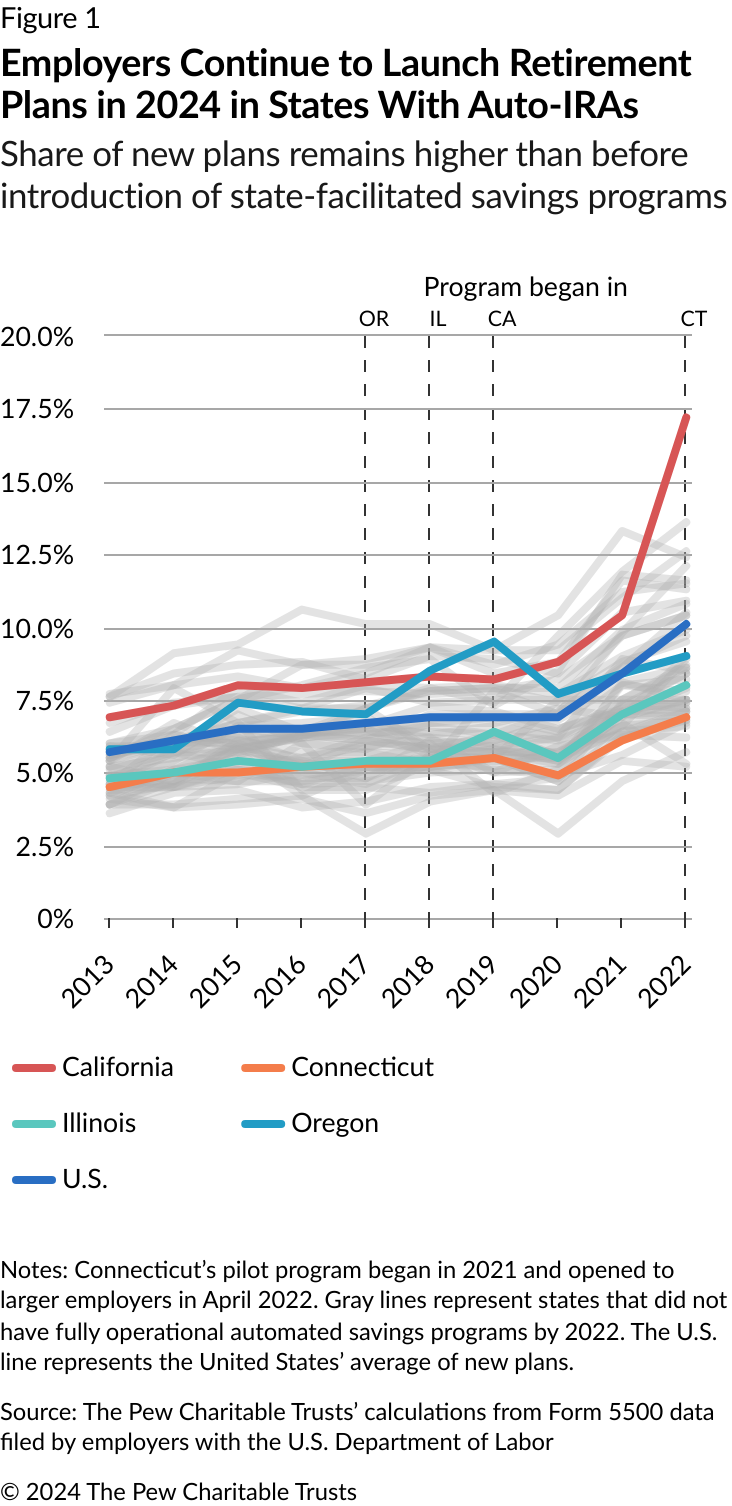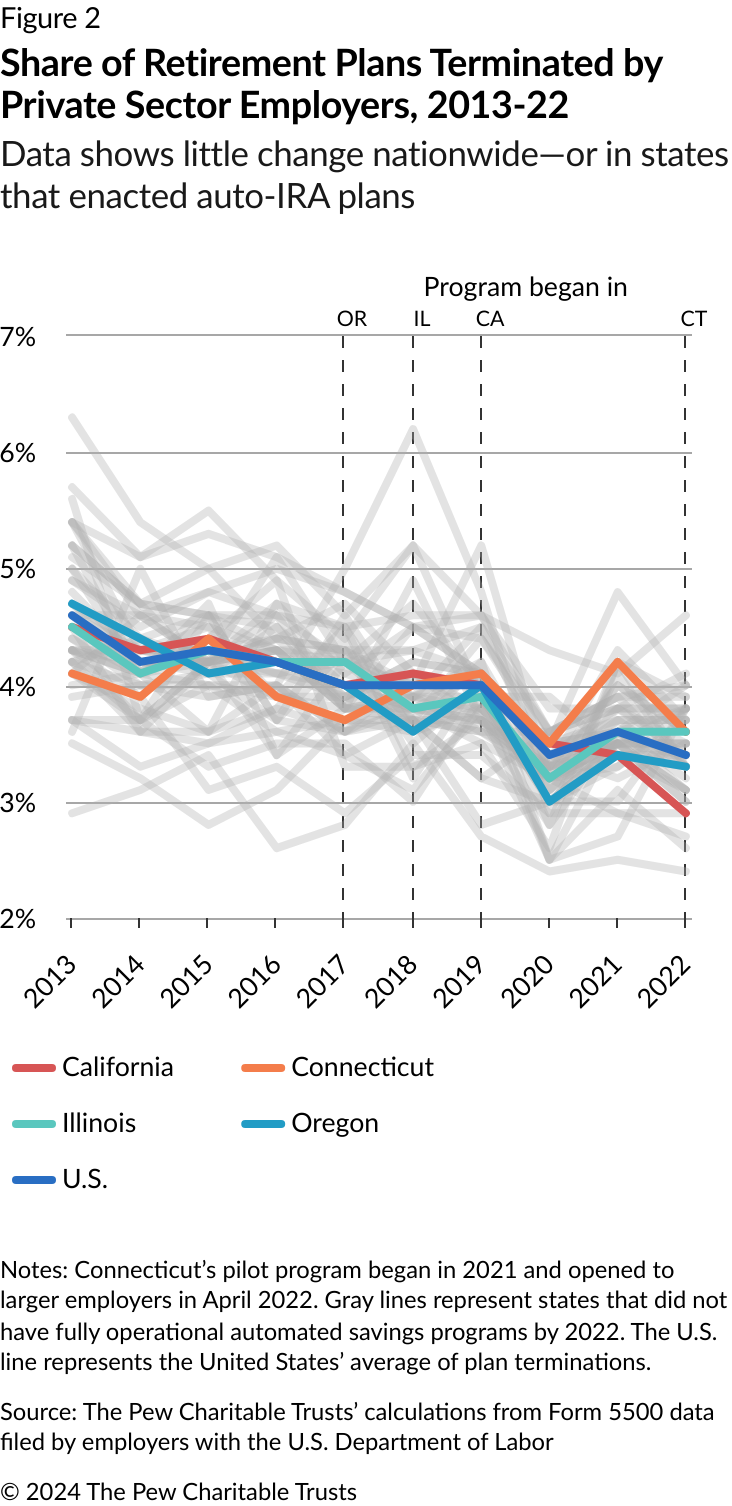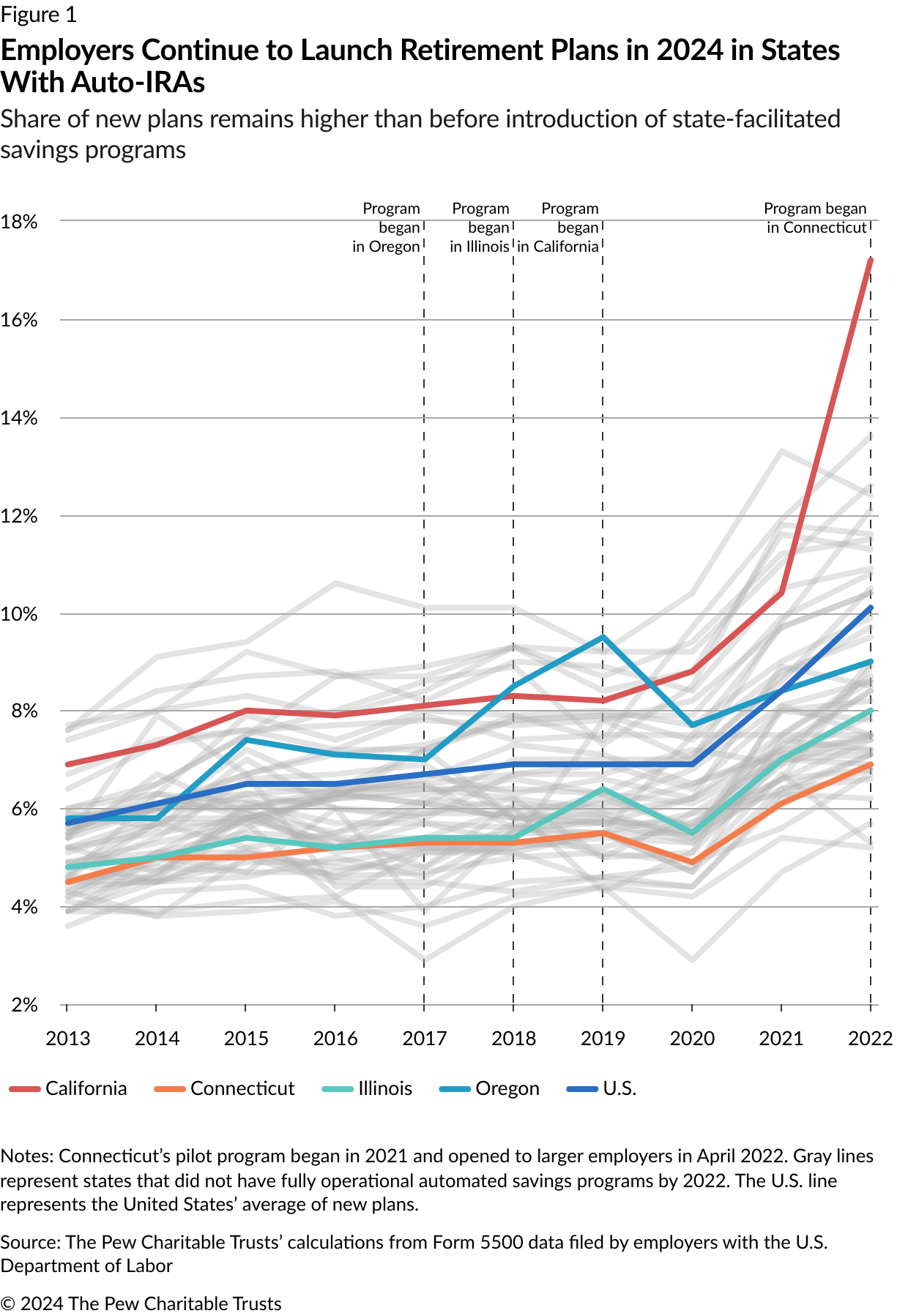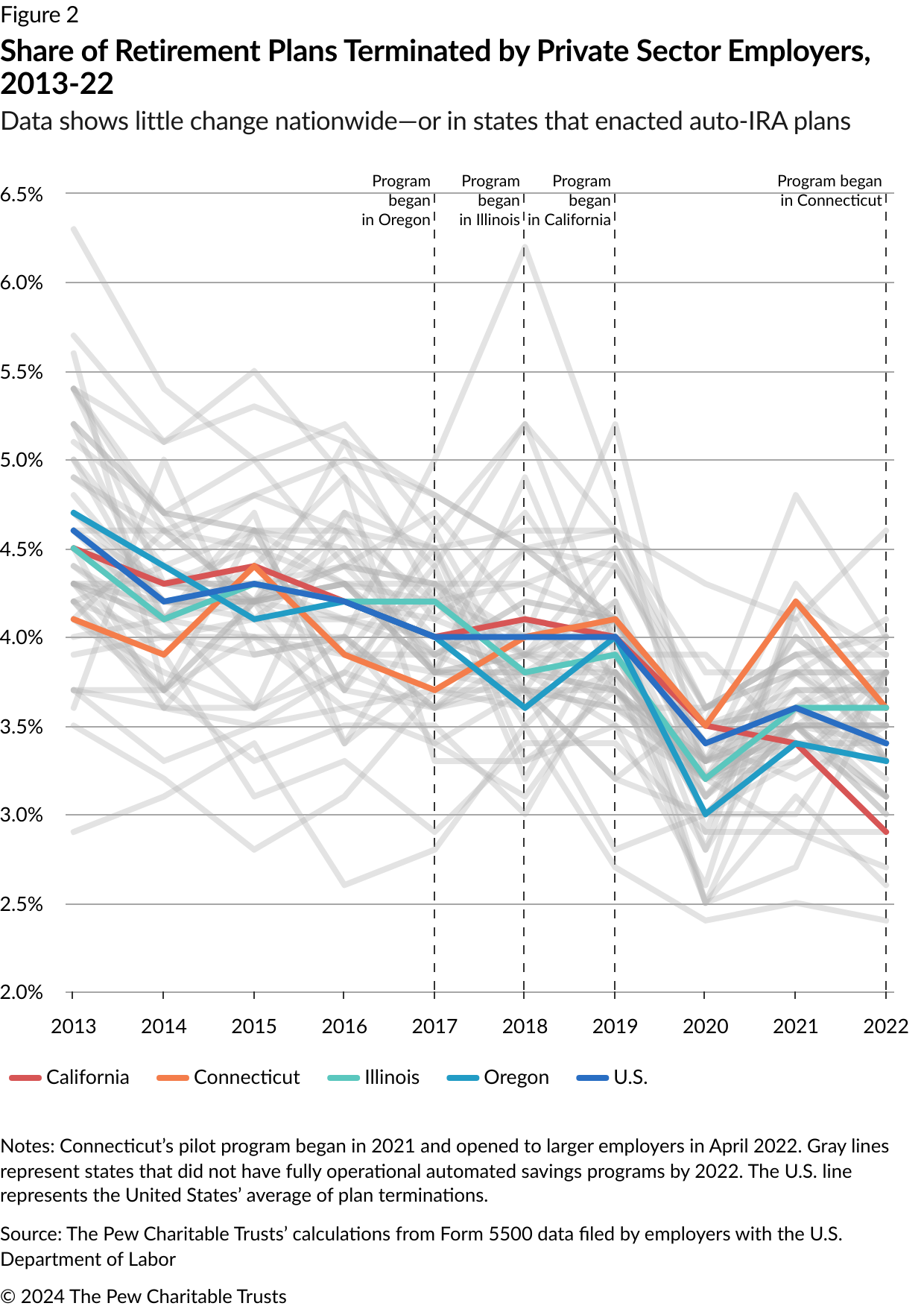State Automated Retirement Programs Don’t Crowd Out Private Plans
New data shows state savings programs work well with private sector plans

Editor’s note: Figures and 1 and 2 were revised on Nov. 18, 2024, to reflect the correct year that California’s program was launched.
Note: This article updates with new data a piece published in April 2023.
Throughout 2022, businesses in California, Illinois, and Oregon—three of the first states to implement statewide automatic enrollment programs to help private sector workers save for retirement—were still creating new private sector pension plans and shedding existing plans at rates slower than or largely comparable to the national average, according to an analysis of federal data. In addition, a fourth state, Connecticut, which began rolling out its statewide program in April 2022, showed an increase in the creation of new private sector plans without an uptick in terminations of these plans.
This data suggests that the presence in these states of state-facilitated individual retirement accounts with automatic enrollment—also known as auto-IRAs—is complementing, not competing with, the private retirement plan market.
The growing number of auto-IRAs has led policymakers and analysts to examine how they are affecting employer-sponsored plans. They offer a retirement savings option to workers who lack access to one through their jobs. Seventeen states have adopted these auto-IRA programs, and according to the Georgetown University Center for Retirement Initiatives, across the eight states with automated savings plans for which data was available as of the end of August 2024, more than 900,000 funded accounts had amassed about $1.7 billion in assets.
Some have asked whether these state programs might “crowd out” the private market for plans. Could the presence of state-run retirement plans prompt businesses to forgo adopting their own 401(k)s, or could some employers terminate existing plans in favor of the state plans? Alternatively, could these programs encourage employers to adopt new plans with higher ceilings on annual savings and the potential for employer matching contributions?
Pew conducted an initial examination of data from the annual filings by employer-sponsored plans from 2013 to 2019 to the U.S. Department of Labor. The analysis suggested that, in those states that have created auto-IRA programs, employers with plans continue to offer them, and businesses without plans are adopting new ones at rates similar to before the state options were available. With this report, updated data for 2022 shows similar results.
Workplace savings plans are one of the most important factors in helping people save for retirement. According to the Center for Retirement Research, few workers without access to a workplace plan save on their own. Yet 48% of private sector employees—almost 57 million people—work for an employer that does not offer either a traditional pension or a retirement savings plan. Pew research showed that just 30% of nontraditional workers—independent contractors, gig workers, self-employed workers, and others—had access to a workplace retirement plan.
Earlier research suggested that auto-IRAs would complement, not compete with, the private retirement plan market. In 2017, Pew published the results of a national survey of small-business owners and benefits managers that detailed their views of hypothetical auto-IRA programs. Among those whose companies had retirement plans, only 13% said they would drop theirs and enroll in such a program if one was available in their state. Among small employers without plans, 51% said they would start their own plan rather than enroll workers in the state-facilitated program.
The updated analysis of employer plan annual filings is consistent with Pew’s prior research. As shown in Figure 1, California’s share of new plans compared with existing ones was the highest in the country in 2022, perhaps because more than 200,000 employers were required to register for auto-IRAs by June 30, 2022, if they didn’t already offer a retirement plan or claim an exemption as a plan sponsor. By Dec. 31, 2022, more than 100,000 California employers covered by the 2022 deadline claimed an exemption. Illinois and Connecticut, meanwhile, have had a lower share of new to existing plans than the national average since 2013, which has not changed. In all four states with auto-IRAs, the rate of introduction of new plans, as a share of existing plans, is higher at program implementation than before these states introduced the savings programs. There is usually an increase in new plan formation when the state programs start or at major implementation deadline dates, as was the case with California in 2022.

The results for state programs largely track trends across the nation, particularly showing an uptick in new plans after 2020. The state auto-IRAs may be nudging employers to adopt their own retirement plans, but other factors may be contributing to the overall trend of establishing new plans. The post-pandemic improvement in the economy may be helping as well as new incentives for employers from the 2019 passage of the SECURE 1.0 legislation, which made it easier and less expensive for small business owners to set up retirement plans for their employees.
Turning to Figure 2 below, the rate of plan terminations nationwide fell by 0.3% between 2021 and 2022. In California, termination rates dipped by a larger amount (-0.55%) in 2022 and in Oregon by -0.2%; in Illinois termination rates held steady. In Connecticut, which began to implement a state-facilitated retirement savings plan in 2022, the rate of terminations dropped by 0.7% over that year. These results indicate that employers in states with auto-IRA programs are not canceling their own retirement plans at higher rates than the national average.

This evidence from California, Oregon, Illinois, and now Connecticut continues to indicate that auto-IRAs complement, instead of crowding out, private sector retirement plans such as employer-sponsored 401(k)s. Similar results are being found in industry data as well as in academic research. At the same time, auto-IRAs allow businesses that cannot afford their own plans to take advantage of a no-cost, basic savings program for their workers. Further research and study in future years will help clarify how employers and plan sponsors respond to these initiatives in states implementing auto-IRA programs.
How the retirement plan adoption rates were calculated
The data comes from federal Form 5500 Annual Reports, a required regulatory filing to the U.S. Department of Labor (DOL) for sponsors of retirement and welfare benefit plans. Pew drew on data from Form 5500s and Form 5500-SFs, or short forms—typically for plans with fewer than 100 participants—from 2013 to 2022.
Using the benefit codes provided by the filers, Pew limited the review to employers offering retirement plans, including defined benefit and defined contribution plans. Plan sponsors are required to file just once per plan per year, and a plan with participants across several states would be represented only in the state where it was filed and may include workers in additional states. When employers filed multiple times for the same plan within a state or across several states, Pew used the form signature date to keep the most recent filing and drop earlier ones. When the signature date was missing, a default duplicates drop procedure was used. Cases in which a single filing was reported as both an initial filing and a plan termination were dropped.
With this report, Pew updated its methodology. Instead of relying on whether firms ticked boxes on their Form 5500s to indicate an initial or final (termination) filing for a pension plan, the new methodology reviews each plan’s filings year by year to ascertain whether a given filing was indeed the first or last during the period from 2013 to 2022. For initial filings, Pew adopted a five-year look-back (to 2009 filings). For final filings, Pew adopted a two-year look-forward through 2020 and then relied on ticked Form 5500 filing-type boxes for years 2021 and 2022 (the last available year of data).
The DOL’s Form 5500 data continues to be updated, typically around the beginning of each month. The data used for this report, from 2013 through 2022, was downloaded in January 2024.
Theron Guzoto and Mark Hines are research officers and Alison Shelton is a senior research officer with The Pew Charitable Trusts’ retirement savings project.


Americans Are Falling Behind on Their Retirement Goals


Automated Retirement Plans Reduce Taxpayer Burden


Small Employers and Costs of Offering Retirement Plans












